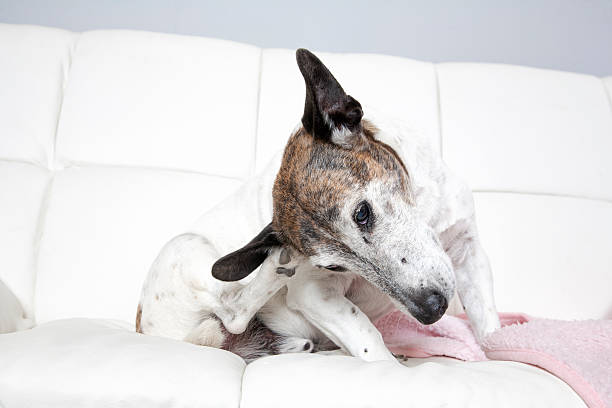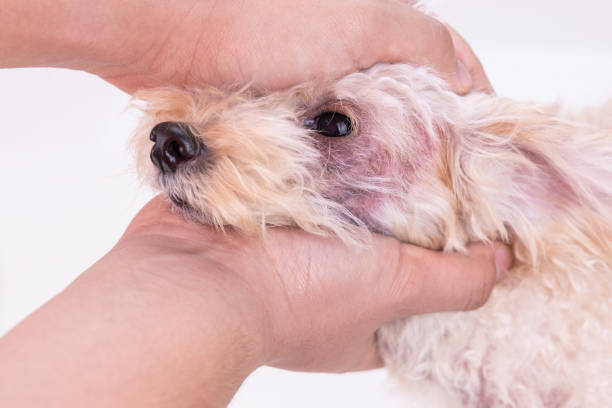Cancer that affects the skin of dogs is a detrimental proliferation that originates from cells in the epidermis or the skin’s outermost layer. It typically manifests on sections of your pet’s body where the fur is less dense and the sun exposure is more prevalent.
These tumours can be benign or malignant.
Benign tumours grow slowly and are not life-threatening. Malignant tumours proliferate and can spread to other organs if left untreated.
Symptoms include:
- Hair loss
- Redness, swelling
- Crusty skin
- Ulcers that do not heal and lumps under the skin
If you notice any of these symptoms in your dog, contact a veterinarian as soon as possible for diagnosis and treatment.


How to Spot Dog Skin Cancer Early On
Dog skin cancer is relatively uncommon but can be deadly. It is also more common in dogs with light coats and those who spend a lot of time outdoors. Dogs usually show symptoms such as hair loss, redness, swelling and crusty skin. There can also be ulcers on the skin that do not heal and lumps under the skin.
An important thing to note: dog skin cancer often starts as a sore or a lump, which means it’s easier to identify early on if you know what to look for! Here are some ways to spot dog skin cancer earlier:
- Wipe your dog down with a damp cloth daily
- Pay close attention to any sores or lumps your dog might have
- Look closely at sunspots, heat bumps or rashes that quickly heal.
- Check your dog’s skin for any changes in pigmentation (i.e. dark spots)
- Teach your pup to love having his coat brushed because it helps you notice small bumps, sores and other changes on their body
- Be reasonable about giving your pooch his annual skin check by a vet.
The symptoms of dog skin cancer are usually pretty easy to spot. They include:
- Hair loss or lesions on the skin that doesn’t heal
- A red, swollen rash for no reason
- Sores that won’t heal and sometimes appear to be getting larger
- Crusty skin or a rash with scabs on it
- Inflamed, flaking skin that also becomes crusty and dry overnight
If your dog has any of these symptoms, especially painful, get them checked out by a vet ASAP! Your dog might need surgery or chemo, depending on how advanced the cancer is.
Dogs with light coats like Pugs, Maltese and white English bulldogs are often more susceptible to sunburn, so it’s essential to be extra careful when they’re outside. These dogs should be kept inside whenever possible and applied sunscreen when necessary.


It’s harder for heavy-coated dogs to regulate their body temperatures, so they should be kept inside as much as possible to avoid overheating problems.
Suppose your dog has already been diagnosed with cancer. In that case, whether melanoma or not, keeping your dog inside as much as possible will reduce their chances of getting another type of cancer.
Melanomas are the most common type of skin cancer in dogs. Still, there can be immune-mediated and non-immune-mediated cancers as well. One such example includes mast cell tumours which often develop as a pet becomes older.
Melanomas can have a variety of different appearances in dogs but are usually either:
- A dark raised growth on the skin that continues growing and is almost always painful or itchy
- A black mole or birthmark under the skin that changes shape and colour over time
- An area of redness or swelling that is not inflamed
There are a few different treatments for dog skin cancer, and it will depend on the type of cancer and where it’s located.
For example, surgery is often needed to remove melanomas. Still, chemotherapy can also be used in conjunction with surgery if the cancer is more advanced. Also, in some cases, removed melanomas are sent to a lab for analysis which is how the doctors will know if it’s malignant or not.
It is essential to understand that this condition can be potentially life-threatening depending on the type of cancer. Be aware of any signs, and getting them checked by a vet right away is highly recommended!


Conclusion
Dogs are susceptible to sunburns and other types of cancer. You must know the signs of dog skin cancer so you can take your pup to a vet sooner rather than later. They include hair loss, redness, swelling, crusty skin, or ulcers on the skin that do not heal.
If your pup has any of these symptoms, it’s time for an appointment with their veterinarian ASAP! Be sure to keep them inside as much as possible if they have already been diagnosed with cancer, too, because this condition can be potentially life-threatening.


